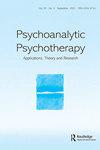心理动力学技术在复杂的创伤后应激障碍中引发情感参与
IF 1.2
Q1 PSYCHOLOGY, PSYCHOANALYSIS
引用次数: 0
摘要
基于暴露模型的治疗方法已被证明在治疗非复杂性创伤后应激障碍(PTSD)方面有效,但在治疗复杂创伤后应激障碍(CPTSD)方面效果较差,因为暴露模型的重要第一步是患者对创伤材料的情感参与。这种接触被CPTSD典型的抑制/解离反应所阻止。已经研究了几种克服这种抑制/解离反应的方法,但已被证明是不切实际的。熟悉的心理动力学技术似乎可以规避抑制/分离反应,并在标准临床环境中引发所需的情感参与。本文章由计算机程序翻译,如有差异,请以英文原文为准。
Psychodynamic techniques elicit emotional engagement in complex post-traumatic stress disorder
Therapies based on an exposure model have been shown to be effective in the treatment of uncomplicated Post-Traumatic Stress Disorder (PTSD), but less effective when used to treat Complex Post-Traumatic Stress Disorder (CPTSD), because an essential first step in the exposure model is a patient’s emotional engagement with traumatic material. This engagement is prevented by a suppressive/dissociative reaction typical of CPTSD. Several methods of overcoming this suppressive/dissociative reaction have been investigated, but have proved impractical. Familiar psychodynamic techniques appear to circumvent the suppressive/dissociative response and elicit the required emotional engagement in standard clinical settings.
求助全文
通过发布文献求助,成功后即可免费获取论文全文。
去求助
来源期刊

Psychoanalytic Psychotherapy
PSYCHOLOGY, PSYCHOANALYSIS-
CiteScore
1.30
自引率
37.50%
发文量
22
期刊介绍:
Psychoanalytic Psychotherapy publishes original contributions on the application, development and evaluation of psychoanalytic ideas and therapeutic interventions in the public health sector and other related applied settings. The Journal aims to promote theoretical and applied developments that are underpinned by a psychoanalytic understanding of the mind. Its aims are consonant with those of the Association for Psychoanalytic Psychotherapy in the NHS (APP in the NHS) in promoting applied psychoanalytic work and thinking in the health care system, across the whole age range.
 求助内容:
求助内容: 应助结果提醒方式:
应助结果提醒方式:


